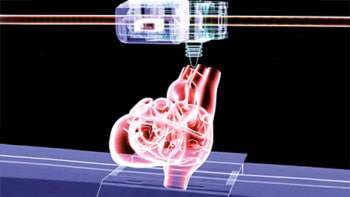
Root canal treatment, a common dental surgery, currently relies on clotted blood to fill the empty tooth canal. Most times it goes well. But having a reliable, biodegradable filling that promotes healing and regeneration of the tooth would be a great advance. Sung Chul Choi from Kyung Hee University, Kyounga Cheon from the University of Alabama at Birmingham and their colleagues have developed a gel filling for root canal treatment that releases nitric oxide and antibiotics inside the treated tooth. The pilot study shows that this new canal filling material has potential for boosting regeneration of the impaired tooth (Plos One 10.1371/journal.pone.0205534).
When the pulp of a tooth, its blood vessels and nerves, is infected, root canal treatment becomes necessary. This can happen when the pulp is exposed following damage caused by caries or mechanical injury. In such cases, the infected tissue inside the tooth is removed, the area is disinfected, medicine and canal filling material are placed in the cavity and the crown is restored.
Currently, blood clots are used as a canal filling material. The composition of these blood clots cannot be controlled and the procedure, while mostly successful, can have negative effects like discolouration or fractures of the tooth. Also, the procedure can damage the tooth’s stem cells, which are needed for regeneration. The team from Seoul consequently set out to develop a better canal filling material.
The new gel is made from peptide amphiphiles, molecules that self-assemble into gel-like structures based on their charge. To add the nitric oxide, the researchers reacted the amphiphiles with poly-lysine as a nitric oxide donor before heat-induced polymerization. The antibiotics ciprofloxacin and metronidazole were encapsulated in the gel during polymerization.

Blood pressure, Viagra and now teeth
The discovery that nitric oxide is a signalling molecule in the body has allowed the development of drugs such as Viagra and drugs to treat high blood pressure. But it seems that nitric oxide signalling, along with its antibacterial effects, can be beneficial for pulp regeneration in teeth too.
The researchers found that nitric oxide-releasing gel had antibacterial effects. Also, nitric oxide helps wound healing and blood vessel growth by preventing death of blood vessel cells (vascular endothelial cells) and by regulating vascular endothelial growth factor. This allows the interior of the treated tooth to regenerate.
Avoiding antibiotic resistance
The local application of antibiotics through a gel inside the tooth is preferable to systemic application to fight antibiotic resistance. Local release exposes only a small number of bacteria to antibiotics, compared with the large number of bacteria in the whole body. It is thought that antibiotic resistance is only beneficial to bacteria that are exposed to antibiotics, as it requires a lot of energy to maintain. Releasing antibiotics directly in the tooth may therefore help to limit the spread of antibiotic resistance.
The antibacterial effect of nitric oxide that the authors observed in their study might actually allow them to leave out the conventional antibiotics completely in the future. This would be even better for preventing antibiotic resistance.
For optimal tooth regeneration three components are required: a biodegradable scaffold; dental mesenchymal stem cells (tooth stem cells); and growth factors. The new gel provides the biodegradable scaffold, while the use of nitric oxide and the applied concentrations of antibiotics seem to have no adverse effect on the stem cells.
In the future, the authors want to supplement the gel with growth factors, to support the growth factors naturally present in the treated tooth.



